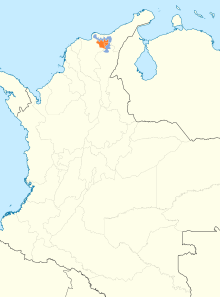Santa Marta sabrewing
| Santa Marta sabrewing | |
|---|---|

| |
| A male, illustrated by J. G. Keulemans. | |
| Scientific classification | |
| Domain: | Eukaryota |
| Kingdom: | Animalia |
| Phylum: | Chordata |
| Class: | Aves |
| Clade: | Strisores |
| Order: | Apodiformes |
| Family: | Trochilidae |
| Genus: | Campylopterus |
| Species: | C. phainopeplus
|
| Binomial name | |
| Campylopterus phainopeplus | |

| |
The Santa Marta sabrewing (Campylopterus phainopeplus) is a
Taxonomy and systematics
The Santa Marta sabrewing has at times been placed in genus Saepiopterus.
Description
The Santa Marta sabrewing is about 13 cm (5.1 in) long. Both sexes have a decurved black bill, with the female's having more curvature, and both have a white spot behind the eye. Males' upperparts are glittering emerald green. They have a black face; their throat and breast are iridescent blue and the rest of their underparts dark green. Their tail is dark steely blue. The female has shining green upperparts and mostly grayish white underparts with green flanks and undertail coverts. Its tail is mostly green with grayish tips on the outermost pair of feathers.[6]
Distribution and habitat
The Santa Marta sabrewing is known only from the northeastern and southern slopes of the isolated Sierra Nevada de Santa Marta of northeastern Colombia. It inhabits the edges of humid forest, plantations (especially of bananas), and bushy páramo. In elevation it ranges from 1,200 to 2,400 m (3,900 to 7,900 ft).[6]
Behavior
Movement
The Santa Marta sabrewing spends the dry season of February to May below 1,800 m (5,900 ft) and moves higher, even as far as the snow line, during the June to October wet season.[6]
Feeding
Almost nothing is known about the Santa Marta sabrewing's feeding strategy or diet. It is known to feed on flowering banana (Musa) and to be territorial.[6]
Breeding
Santa Marta sabrewings in breeding condition have been found between April and June, and males have been seen displaying in June and July. Nothing else is known about the species' breeding phenology and its nest has not been described.[6]
Vocalization
As of mid-2022 only one recording of the Santa Marta sabrewing is known. It makes "a plaintive double 'twit-twit', both in flight and display."[6]
Status
The
Until about 1900 the Santa Marta Sabrewing was described as fairly common, and it was recorded intermittently until 1946.[1] It was not recorded again until 2010 and was then again "lost" until 2022, when its survival was confirmed by photographic evidence of an individual male, found by chance.[5][8][9]
References
- ^ . Retrieved 23 August 2022.
- ^ "Appendices | CITES". cites.org. Retrieved 2022-01-14.
- ^ a b Gill, F.; Donsker, D.; Rasmussen, P., eds. (August 2022). "Hummingbirds". IOC World Bird List. v 12.2. Retrieved August 9, 2022.
- ^ HBW and BirdLife International (2021) Handbook of the Birds of the World and BirdLife International digital checklist of the birds of the world. Version 6. Available at: http://datazone.birdlife.org/userfiles/file/Species/Taxonomy/HBW-BirdLife_Checklist_v6_Dec21.zip retrieved August 7, 2022
- ^ a b Garg, Moohita Kaur (5 August 2022). "Rare hummingbird believed to be extinct spotted after ten years". wionews.com. WION. Retrieved 7 August 2022.
- ^ a b c d e f g Züchner, T., E. de Juana, and P. F. D. Boesman (2020). Santa Marta Sabrewing (Campylopterus phainopeplus), version 1.0. In Birds of the World (J. del Hoyo, A. Elliott, J. Sargatal, D. A. Christie, and E. de Juana, Editors). Cornell Lab of Ornithology, Ithaca, NY, USA. https://doi.org/10.2173/bow.samsab1.01 retrieved August 23, 2022
- ISBN 978-958-716-980-5.
- ^ Cara, Ed (August 5, 2022). "One of the World's Rarest 'Lost Birds' Photographed in Colombia". Gizmodo. Retrieved 13 August 2022.
- ISSN 0261-3077. Retrieved 2023-04-30.

